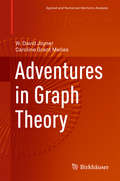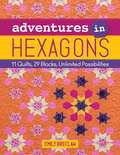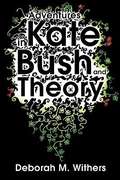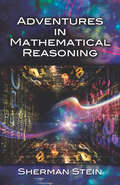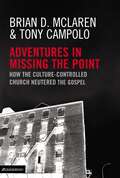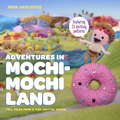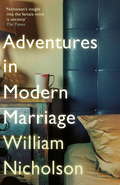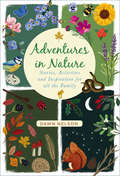- Table View
- List View
Adventures in Food and Nutrition!
by Carol Byrd-BredbennerIntroduce your students to food and nutrition with Adventures in Food and Nutrition! Packed with student appeal, this full-color text generates student interest with action photos, interesting activities, and real-world experiments. The text encourages students to develop scientific and inquiry skills as they learn about nutrition, food management, and preparation. The text is written at a lower level for younger students or beginning level classes. -- Multicultural focus, reflecting foods from a cross section of diverse backgrounds. -- Math and science applications and activities are provided throughout the text and in special-interest features. -- Involves students in the science and creativity of preparing meals and snacks. -- Chapters include Objectives, New Terms, Review Questions, Application Questions, Activities, and a Summary.
Adventures in Food and Nutrition! (Fifth Edition)
by Carol Byrd-BredbennerAdventures in Food and Nutrition! is a great resource for helping your students begin an exciting study of nutrition, food management, and preparation. The appealing, youthful writing style and colorful photographs draw students' attention, and the lower reading level makes this text anexcellent choice for younger students and introductory classes. Interesting features appear throughout the text to encourage students to use math and science concepts as they consider the link between nutrition and health. These features also introduce students to food technology innovations,increase their appreciation of diverse cultures, and motivate them to explore careers. In addition, problem-solving scenarios empower students to develop critical-thinking skills as they apply learning.
Adventures in Franchise Ownership: 4 Pillars to Strengthen, Protect and Grow Your Business
by Christy Wilson DelkWritten in the style of a business &‘tell-all&’, Adventures in Franchise Ownership lays out what successful franchisees do that you won&’t find in most owner&’s manuals and includes franchisee Christy Wilson Delk&’s good, bad, and really tough days before her successful exit 15 years later. Franchisees, like most small business owners, experience times of extreme frustration, lapses in motivation, and often exit before reaching their potential and their goals. Based on Christy&’s real-life franchise ownership adventures, this guide explains how her 4 Pillar to Pillars Approach helps all franchise owners get to the top tier of their franchise system and includes advice from 16 top performers representing over a dozen market segments. With humor, candor, and relatability, Christy fills in the gaps of the franchise Owner&’s Manual by providing a constructive framework for finding professional satisfaction and attaining the financial success franchise owners everywhere want and deserve.
Adventures in Good Cooking
by Duncan HinesAn all-American classic: &“For the first time in decades, we can revisit the best recipes from some of the best restaurants of the &’40s and &’50s.&” —St. Louis Post-Dispatch Adventures in Good Cooking was a culinary landmark. Duncan Hines had left his native Kentucky and crisscrossed the country as a traveling salesman, becoming a national tastemaker in the process by reporting on the many restaurants he visited. Eventually, his recommendations became so popular that he published his first cookbook at age fifty-nine. This bestselling collection featured recipes contributed by select restaurants from coast to coast as well as crowd-pleasing family favorites, and it helped to raise the standard for home cooking in America. Filled with succulent treats, from the Waldorf-Astoria&’s Chicken Fricassee to the Oeufs a la Russe served at Antoine&’s Restaurant in New Orleans to Mrs. Hines&’s own Christmas Nut Cake, this book includes classic recipes from top chefs and home cooks alike. Includes a new introduction by Hines biographer Louis Hatchett and a valuable guide to the art of carving
Adventures in Graph Theory (Applied and Numerical Harmonic Analysis)
by W. David Joyner Caroline Grant MellesThis textbook acts as a pathway to higher mathematics by seeking and illuminating the connections between graph theory and diverse fields of mathematics, such as calculus on manifolds, group theory, algebraic curves, Fourier analysis, cryptography and other areas of combinatorics. An overview of graph theory definitions and polynomial invariants for graphs prepares the reader for the subsequent dive into the applications of graph theory. To pique the reader's interest in areas of possible exploration, recent results in mathematics appear throughout the book, accompanied with examples of related graphs, how they arise, and what their valuable uses are. The consequences of graph theory covered by the authors are complicated and far-reaching, so topics are always exhibited in a user-friendly manner with copious graphs, exercises, and Sage code for the computation of equations. Samples of the book's source code can be found at github. com/springer-math/adventures-in-graph-theory. The text is geared towards advanced undergraduate and graduate students and is particularly useful for those trying to decide what type of problem to tackle for their dissertation. This book can also serve as a reference for anyone interested in exploring how they can apply graph theory to other parts of mathematics.
Adventures in Graphica: Using Comics and Graphic Novels to Teach Comprehension, 2-6
by Terry ThompsonGraphica is a medium of literature that integrates pictures and words and arranges them to tell a story or convey information, usually presented in a comic strip, periodical, or book form AKA comics. It's no surprise comics have long been popular with kids and adults; some of our greatest heroes were introduced to us in comic form. Drawing on his own success using graphica with elementary students, literacy coach Terry Thompson introduces reading teachers to this popular medium in Adventures in Graphica: Using Comics and Graphic Novels to Teach Comprehension, Grades 2-6. In his book, Thompson explains how graphica can be an engaging and motivating tool for reluctant readers who often shun traditional texts. He suggests sources of appropriate graphica for the classroom and demonstrates how to fit this medium into the literacy framework and correlates with best practices in comprehension, vocabulary, and fluency instruction.Adventures in Graphica contains numerous, easy-to-replicate, instructional strategies, including examples of how graphic texts can be used to create a bridge and students transfer abstract comprehension strategies learned through comics and graphic novels to traditional texts. It is an excellent roadmap for teachers looking to add graphica to their classrooms.
Adventures in Group Theory: Rubik's Cube, Merlin's Machine, and Other Mathematical Toys
by David JoynerThis updated and revised edition of David Joyner’s entertaining "hands-on" tour of group theory and abstract algebra brings life, levity, and practicality to the topics through mathematical toys.Joyner uses permutation puzzles such as the Rubik’s Cube and its variants, the 15 puzzle, the Rainbow Masterball, Merlin’s Machine, the Pyraminx, and the Skewb to explain the basics of introductory algebra and group theory. Subjects covered include the Cayley graphs, symmetries, isomorphisms, wreath products, free groups, and finite fields of group theory, as well as algebraic matrices, combinatorics, and permutations.Featuring strategies for solving the puzzles and computations illustrated using the SAGE open-source computer algebra system, the second edition of Adventures in Group Theory is perfect for mathematics enthusiasts and for use as a supplementary textbook.
Adventures in Hexagons: 11 Quilts, 29 Blocks, Unlimited Possibilities
by Emily Breclaw“Expert step-by-step instructions to help you create a stunning quilt that will make your friends ask, ‘How did you do that?’” —Quilter’s ConnectionMove beyond one-patch hexagon layouts with eleven show-stopping hexie projects to stitch by hand or machine. Sew blocks in a variety of sizes and pieced combinations for stunning visual effects! You’ll master the Y-seam with a variety of techniques to cut and piece hexagons. Mix it up with the author’s design primer, which gives you the tools to draft your own unique hexie quilt layout.“Breclaw’s thoughtful instruction and logical processes for assembly will guide both beginners and experienced quilters.” —Library Journal
Adventures in Human Being: A Grand Tour from the Cranium to the Calcaneum
by Gavin FrancisWe assume we know our bodies intimately, but for many of us they remain uncharted territory, an enigma of bone and muscle, neurons and synapses. How many of us understand the way seizures affect the brain, how the heart is connected to well-being, or the why the foot holds the key to our humanity? In Adventures in Human Being, award-winning author Gavin Francis leads readers on a journey into the hidden pathways of the human body, offering a guide to its inner workings and a celebration of its marvels.Drawing on his experiences as a surgeon, ER specialist, and family physician, Francis blends stories from the clinic with episodes from medical history, philosophy, and literature to describe the body in sickness and in health, in life and in death. When assessing a young woman with paralysis of the face, Francis reflects on the age-old difficulty artists have had in capturing human expression. A veteran of the war in Iraq suffers a shoulder injury that Homer first described three millennia ago in the Iliad. And when a gardener pricks her finger on a dirty rose thorn, her case of bacterial blood poisoning brings to mind the comatose sleeping beauties in the fairy tales we learn as children.At its heart, Adventures in Human Being is a meditation on what it means to be human. Poetic, eloquent, and profoundly perceptive, this book will transform the way you view your body.
Adventures in Improv Quilts: Master Color, Design & Construction
by Cindy GrisdelaTake on color and creativity—discover three different ways to improv quilt, creating one-of-a-kind works of art. Find inspiration in Improv and start your journey with bold colors and unique designs! Improv expert Cindy Grisdela shares the design principles and construction strategies for successful quilts every time. Explore three different ways to create improvisationally, from the easiest―using one block in different colors and orientations―to combining block units using various techniques―to aspirational, free cutting the entire quilt and designing it on the wall before sewing. Finished creations result in one-of-a-kind artwork! · Master three different improvisational styles to create original works of art · Design and construction process made easy with expert strategies Guided exercises will have you creating stunning Improv quilts in no time
Adventures in Kate Bush and Theory
by Deborah M. WithersAdventures in Kate Bush and Theory will present Kate Bush as you have never seen her before. Here is the polymorphously perverse Kate, the witchy Kate, the queer Kate; the Kate who moves beyond the mime. Drawing on cutting edge feminist philosophy, critical theory and queer studies, Adventures in Kate Bush and Theory makes theory accessible to new audiences. Through analysis of the music, film, video and dance of Kate Bush, it breaks down boundaries between the academic and popular, showing that theory can be sordid, funny and relevant - despite what most people think.
Adventures in Letterpress
by Brandon MiseTactile, retro and idiosyncratic, hand-printed objects have an undeniable appeal, especially in a digital age. In recent years, the nearly obsolete craft of letterpress has been resurrected by artists and designers who have rescued cast-iron presses from basements and scrap yards. Adventures in Letterpress features over 200 examples of the resulting work: elegant cards, edgy broadsheets and everything in between. Beautiful, humorous and sometimes just plain weird, the projects featured in the book perfectly illustrate the vibrant future of this once-endangered medium.
Adventures in Letterpress
by Brandon MiseTactile, retro and idiosyncratic, hand-printed objects have an undeniable appeal, especially in a digital age. In recent years, the nearly obsolete craft of letterpress has been resurrected by artists and designers who have rescued cast-iron presses from basements and scrap yards. Adventures in Letterpress features over 200 examples of the resulting work: elegant cards, edgy broadsheets and everything in between. Beautiful, humorous and sometimes just plain weird, the projects featured in the book perfectly illustrate the vibrant future of this once-endangered medium.
Adventures in Marxist Theory: Toward a Reconstruction of Marxism in the Contemporary Era
by Douglas KellnerAdventures in Marxist Theory provides an introduction and overview of Marxian theory to demonstrate its contemporary relevance to social and political theory and a range of disciplines from philosophy to economics in both the humanities and the social sciences. The text argues that current historical developments and the evolution of economics, politics, society, culture, technology, and everyday life demonstrates the contemporary relevance of Marxism in both theory and politics in the contemporary era.The book presents a twenty-first century Marxism relevant to theorizing contemporary state capitalist and technological societies, critically dissecting their major social and political issues and problems, while advancing progressive social transformation in the interests of increased democracy and social justice. The volume opens with an Introduction describing a multi-disciplinary and critical approach to Marxism and its application to a wide range of contemporary issues, including the alienation of labor in the workplace, social divisions, and injustices such as classism, sexism, racism, and homophobia, and questions of technology, social media, and AI, as well as problems of ecological crisis, autocracy, and state oppression. Specific chapters address the Marxian critique of capitalism and theory of socialism, its concept of ideology and morality, its methodological synthesis of social science, critical theory, and its analyses of globalization, technology, and democracy.Written by a distinguished scholar of Marxism, critical theory, and cultural and political studies, the volume will be a key resource for instructors, students, and readers in historical and contemporary sociology, social and critical theory, political sociology, political and cultural studies, and Marx and Marxist studies.
Adventures in Mathematical Reasoning
by Sherman SteinEqually appealing to beginners and to the mathematically adept, this book bridges the humanities and sciences to explore applications behind computers, cell phones, measurement of astronomical distance, cell growth, and other areas. Eight fascinating examples show how understanding certain topics in advanced mathematics requires nothing more than arithmetic and common sense.Each chapter begins with a question about strings consisting of nothing more than two letters, and every such question raises intriguing problems to be explored and solved. Author Sherman Stein proceeds at a measured pace that permits readers to move through the chapters in a leisurely fashion, omitting none of the steps. His approach makes complex subjects -- from topology to set theory to probability -- both accessible and exciting.
Adventures in Minecraft
by Martin O'Hanlon David WhaleHere's your ticket to a world of adventures with Minecraft and programming.Learn how to extend Minecraft and create a new gaming experience, by exploring the magical world of Minecraft programming. Adventures in Minecraft, like other books in the highly successful Adventures series, is written especially for 11- to 15-year-olds. With this book you will learn new programming skills while having fun with Minecraft! Minecraft programming experts David Whale and Martin O'Hanlon walk you step-by-step through everything you need to know to: Get started writing Minecraft programs in Python on your PC, Mac, or Raspberry Pi * Build houses and other structures in the blink of an eye, and make a 3D duplicating machine * Write interactive games like a field that charges you rent, and a treasure hunt using magic vanishing bridges * Build custom game control panels using simple electronic circuits * Easily build huge 2D and 3D structures such as spheres and pyramids * Build intelligent objects like a massive Minecraft clock, and program an alien invasion * Plan and write a complete interactive arena game * Using the programming skills you learn from this book, writing Minecraft programs offers endless possibilities to create anything you can imagine.
Adventures in Minecraft (Adventures In ... Ser.)
by Martin O'Hanlon David WhaleLearn valuable programming skills while building your own Minecraft adventure! If you love playing Minecraft and want to learn how to code and create your own mods, this book was designed just for you. Working within the game itself, you'll learn to set up and run your own local Minecraft server, interact with the game on PC, Mac and Raspberry Pi, and develop Python programming skills that apply way beyond Minecraft. You'll learn how to use coordinates, how to change the player’s position, how to create and delete blocks and how to check when a block has been hit. The adventures aren't limited to the virtual – you'll also learn how to connect Minecraft to a BBC micro:bit so your Minecraft world can sense and control objects in the real world! The companion website gives you access to tutorial videos to make sure you understand the book, starter kits to make setup simple, completed code files, and badges to collect for your accomplishments. Written specifically for young people by professional Minecraft geeks, this fun, easy-to-follow guide helps you expand Minecraft for more exciting adventures, and put your personal stamp on the world you create. Your own Minecraft world will be unlike anyone else's on the planet, and you'll pick up programming skills that will serve you for years to come on other devices and projects. Among other things, you will: Write Minecraft programs in Python® on your Mac®, PC or Raspberry Pi® Build houses, structures, and make a 3D duplicating machine Build intelligent objects and program an alien invasion Build huge 2D and 3D structures like spheres and pyramids Build a custom game controller using a BBC micro:bit™ Plan and write a complete interactive arena game Adventures in Minecraft teaches you how to make your favourite game even better, while you learn to program by customizing you Minecraft journey.
Adventures in Missing the Point: How the Culture-Controlled Church Neutered the Gospel
by Brian D. Mclaren Tony CampoloIf you’re brave enough to take an honest look at the issues facing the culture–controlled church–and the issues in your own life–read on. Do you ever look at how the Christian faith is being lived out in the new millennium and wonder if we’re not doing what we’re supposed to be doing? That we still haven’t quite “gotten it”? That we’ve missed the point regarding many important issues? It’s understandable if we’ve relied on what we’ve been told to believe or what’s widely accepted by the Christian community. But if we truly turned a constructive, critical eye toward our beliefs and vigorously questioned them and their origins, where would we find ourselves? Best-selling authors Brian McLaren and Tony Campolo invite you to do just that. Join them on an adventure–one that’s about uncovering and naming faulty conclusions, suppositions, and assumptions about the Christian faith. In Adventures in Missing the Point, the authors take turns addressing how we’ve missed the point on crucial topics such as: Salvation, The Bible, Being Postmodern, Worship, Homosexuality, Truth, and many more…
Adventures in Mixed Media Art: Inspiration, Techniques and Projects for Painting, Collage and More
by Amy JonesAre you inspired by mixed-media art but don't know where to start?Adventures in Mixed Media Art is the ultimate guidebook for embarking on your own creative adventure! Featuring 20 favorite mixed-media projects from the bestselling North Light backlist, this "best of the best" collection will motivate any would-be artist to start creating!Beginning with motivational readings, you will discover and learn to refine your creative energy by discovering what inspires you. Then you are ready to create your very own art journal using guided mixed-media techniques, including hand lettering and basic painting and collage techniques.When you're ready to create and refine your signature style, you'll start creating canvas paintings, collages and assemblage pieces based on projects from popular mixed-media artists like Dina Wakley, Mary Beth Shaw, and more. Even if your project doesn't turn out as planned, the book includes helpful tips and techniques for repurposing those pieces into a new work of art you can proudly display. The book also includes collaborative projects so you can encourage others to start their own Adventures in Mixed Media!
Adventures in Mochimochi Land
by Anna HrachovecWhat do a talking doughnut, a crabby politician, and a lovelorn balloon have in common? They're all citizens of the candy-colored knitted world known as Mochimochi Land. Adventures in Mochimochi Land started out as a collection of tiny knitted characters, but as the patterns grew they needed an entire world of their own, complete with knitted cities, knitted forests, knitted oceans, and most important, knitted friends! The book follows the adventures of a tiny knitted explorer, as he travels this unbelievably cute world and uncovers its strange yarn-based origins. For intrepid knitters, the book also includes a section with 25 all-new patterns for the characters and props used in the stories. The patterns use small amounts of yarn and beginner-friendly knitting skills and knit up quickly for instant fun.
Adventures in Modern Marriage
by William NicholsonWith pace, wit and a beady eye, Adventures in Modern Marriage revisits the characters from Nicholson's highly acclaimed The Secret Intensity of Everyday Life. But now the children are grown up, and the adults are older, though not always wiser. Here is a big-hearted novel about life and love in the bestselling vein of Colm Toibin and Nick Hornby'So incredibly accurate and true. Utterly captures the sense of quiet desperation of ordinary lives ... and the ways in which life turns on a sixpence' Kate Mosse on The Secret Intensity of Everyday LifeFocusing on Henry and Laura Broad and their daughter Carrie, this is a minute - but in true Nicholson style, extraordinarily empathetic - dissection of relationships and what keeps them going. It is an acute and compassionate look at male mid-life crises, female sexual desire, death and the fear of it, children and the trouble with them - all the things we battle with every day.
Adventures in My Youth: A German Soldier on the Eastern Front 1941–45
by Armin ScheiderbauerThe author could be described as a 'veteran' in every sense of the word, even though he was only aged 21 when the war ended. Armin Scheiderbauer served as an infantry officer with the 252nd Infantry Division, German Army, and saw four years of bitter combat on the Eastern Front, being wounded six times. This is an outstanding personal memoir, written with great thoughtfulness and honesty.Scheiderbauer joined his unit during the winter of 1941/42, and during the following years saw fierce combat in many of the largest battles on the Eastern Front. His experiences of the 1943-45 period are particularly noteworthy, including his recollections of the massive Soviet offensives of summer 1944 and January 1945. Participating in the bitter battles in East Prussia, he was captured by the Soviets and not released until 1947.Adventures in my Youth is a unique memoir—the author originally wrote it only for his daughter. It has never been published in any language, until now.
Adventures in Nature: Speed and Comprehensive Reader
by Marion Hedquist Michelle Johnson Dawn Mereness Phyllis RandBeginning in fourth grade, the reading program provides specific opportunities for students to develop comprehension skills. At this level, students are responsible for much more history and science material and outside reading. Their vocabulary work is increased, and they are expected to retain many more facts. Begin now to stress the importance of reading for information at the best possible speed. Because the reading program for the lower elementary grades stresses phonics and reading mastery, students are now ready to work on these other reading skills.
Adventures in Nature: Stories, Activities and Inspiration for all the Family
by Dawn NelsonThrough a mixture of original stories and traditional tales, Adventures in Nature offers an abundance of ways for families to connect with the earth. As our ancestors did before us, the book follows the seasons contained in the ‘Wheel Of The Year’, with each entry focusing on a story that brings us closer to the natural world, accompanied by simple craft projects, activities and mindful moments.In our busy, modern lives we have become increasingly disconnected from the world around us, and stories are an age-old way of re-establishing that link, nurturing a love for the environment and embedding awareness and respect for the planet within our culture.This book allows you to discover your very own adventures in nature through story.
Adventures in Nowhere
by John AmesBefore Disney and far from the palm-lined Florida beaches, ten-year-old Danny Ryan is transplanted to a tiny community on the hyacinth-choked Hillsborough River outside Tampa, a place his older sister calls Nowhere. But for Danny and his best friend, the irrepressible Alfred Bagley, whose fondest desire is to grow up to be a junk dealer, Nowhere is where adventures lurk and lure them into more trouble than they can handle. More trouble is not what Danny needs as he copes with a family that includes a father sinking into schizophrenia; two sisters, one very ill and the other ready to run away with a shady boyfriend; and a mother trying her best to hold it all together. Yet Danny keeps his good humor, seeking escape on the nearby Hillsborough River or in the little community of Sulphur Springs. But Danny's adventures take a fateful turn when he begins seeing a mysteriously changing house across the hyacinth-choked Hillsborough. Is he going crazy like his father? With the help of a small band of quirky but faithful allies, Danny searches for and finds himself.Adventures in Nowhere paints a compelling, imaginative, and often humorous vision of a time, a place, and a way of growing up, allowing a reader to live for a while in the mind of a remarkably thoughtful and intense boy caught at the final edge of childhood.




